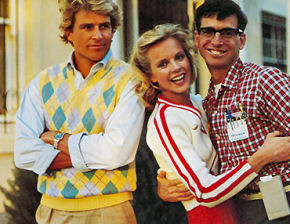27 October 2012
"It's not you, it's me," means it's probably you, say ovulation boffins
by Will Parker
 Long after women have chosen Mr. Stable over Mr. Sexy, they struggle unconsciously with the decision, with the highest levels of dissatisfaction occurring during ovulation. The new findings, from UCLA's Martie Haselton, appear in the journal Hormones and Behavior and add to previous research that showed how ovulation affects perception and female behaviors.
Long after women have chosen Mr. Stable over Mr. Sexy, they struggle unconsciously with the decision, with the highest levels of dissatisfaction occurring during ovulation. The new findings, from UCLA's Martie Haselton, appear in the journal Hormones and Behavior and add to previous research that showed how ovulation affects perception and female behaviors.
Haselton's new work shows that at their most fertile period, women with reliable but unexciting partners are less likely to feel close to their mates and more likely to find fault with them than women mated to more sexually desirable men. "A woman evaluates her relationship differently at different times in her cycle, and her evaluation seems to be colored by how sexually attractive she perceives her partner to be," explained Haselton.
"A lot of research has shown that women's preferences change over the course of the cycle, but this is the first time that these changes have been shown to have implications for relationship functioning," added co-researcher Christina Larson.
The study involved asking women a series of questions about the sexual attractiveness of their mates and their stability or suitability as a long-term mate. Then at two different points in her monthly cycle - at high fertility (just before ovulation) and at low fertility - each woman was asked about the quality of her romantic relationship.
The researchers found no significant change across the cycle in how the women perceived their level of commitment to the relationship or, at least initially, in their satisfaction with it. But an exercise that required the women to rate how close they felt to their men yielded dramatic results. As women mated to less sexually attractive men moved from their least fertile to most fertile period, their closeness scores dropped dramatically. Additionally, the women mated to the less sexually attractive men were significantly more likely to find fault with their partners
Women mated to the most sexually attractive men, meanwhile, experienced the opposite effect. As these women moved from their least to most fertile period, their closeness scores rose by a point.
Haselton believes the findings shed light on a suite of conflicting behaviors that stem from mating strategies that might have provided an evolutionary benefit to women's female ancestors of long ago. She calls the urge for a stable long-term partner along with the increased desire for a more sexually attractive mate during periods of high fertility the "dual mating hypothesis."
"A deep voice, masculine face, dominant behavior and sexy looks... it is possible that we evolved to feel drawn to these visible markers because, at least in the past, they proved to be indicators of good genes," she said. "Ancestral women who were attracted to these features could have produced offspring who were more successful in attracting mates and producing progeny."
But, she adds, these evolutionary traits today probably serve no other purpose than to stir the domestic pot.
Haselton and Larson next plan to look at whether fault-finding and the feelings of distance and dissatisfaction have any long-term destabilizing effects on the relationships of women with less sexually attractive men. They also plan to look into how, if at all, the behavior is perceived by the male partners of these women.
"We don't know if men are picking up on this behavior, but if they are, it must be confusing for them," Larson said.
Related:
Discuss this article in our forum
Male testosterone levels surge with ovulation
Ovulation puts gaydar into overdrive
Semen found to induce ovulation
Source: University of California - Los Angeles
